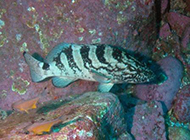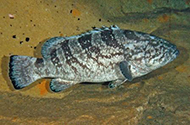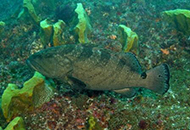
Priorities Action Statement - Actions for Black Rockcod
 A
juvenile Black Rockcod
A
juvenile Black Rockcod
© D. Harasti
 An
adult Black Rockcod
An
adult Black Rockcod
© D. Harasti
Recovery Actions
Advice to consent and determining authorities
- Ensure that councils, government agencies and other relevant organisations are aware of the location of important areas for Black Rockcod, for example, by providing maps of known and potential habitat and the location of significant populations (High priority).
- Provide other relevant information to support appropriate planning and impact assessment (e.g. Environmental Impact Assessment Guidelines) (High priority).
- Negotiate with local councils and industry groups regarding the type and scale of development near key areas known to support populations of Black Rockcod (High priority).
Collate and review existing information
- Contribute to the design of observer programs in the Ocean Trap and Line Fishery and Estuary General Fishery to quantify the extent of interactions between these fisheries and Black Rockcod. Compile and disseminate existing records of the interaction of bottom-set baited hooks and line fishing methods with Black Rockcod (Medium priority).
- Collate and synthesise data collected to quantify the significance of high and moderate risk threat interactions with Black Rockcod (Medium priority).
Community and stakeholder liaison, awareness and education
- Address identification issues by developing and distributing practical identification materials for fishers and spearfishers by making them readily available on the NSW DPI website (High priority).
- Promote the use of fishing techniques and gear that eliminate or mitigate the impact of high and moderate risk activities on Black Rockcod. Specifically promote techniques and gear that avoid the capture of Black Rockcod and minimise impacts on accidentally caught fish (High priority).
- Produce advisory material to assist in raising awareness of the identification of Black Rockcod and the protected status of the species and distribute this information to relevant stakeholders including fishing and dive clubs (High priority).
- Encourage fishers/spearfishers and managers to record the capture location and approximate length and weight of incidentally caught Black Rockcod in NSW to the Threatened and Protected Species Sighting Program, and via mandatory reporting arrangements for commercial fisheries and shark meshing contractors (Medium priority).
- Collaborate with recreational and commercial fishing magazines to enhance publicity about Black Rockcod to improve species identification, the reporting of interactions with Black Rockcod, and to promote best practice techniques for handling and releasing incidentally caught Black Rockcod (Medium priority).
- Work with commercial aquaria to increase public awareness of the status and threats to Black Rockcod (Low priority).
Compliance / enforcement
- Incorporate Black Rockcod issues into the NSW DPI Annual District Compliance Plans (High priority).
- Maximise compliance activities at identified important sites and, where necessary, increase protection of Black Rockcod at these sites through regulatory controls (High priority).
Enhance, modify or implement NRM planning processes to minimize adverse impacts on threatened species
- Consider information on Black Rockcod distribution, abundance and habitat preferences during development and review of Marine Park Zoning Plans (Medium priority).
- Implement the NSW Diffuse Source Water Pollution Strategy to coordinate efforts to reduce diffuse source water pollution impacting on Black Rockcod habitat (Medium priority).
- Negotiate with relevant authorities to encourage the identification, assessment and modification of natural resource management plans and policies to minimise impacts on Black Rockcod habitats and water quality (Medium priority).
Research / monitoring
- Continue to monitor the distribution and abundance of Black Rockcod at important sites to inform population status and to assist in determining the effectiveness of recovery actions (Medium priority).
- Initiate collaborative projects to investigate the biology and ecology of Black Rockcod (e.g. life history, habitat requirements, fecundity, reproductive biology, movements, response to climate change and water pollution etc.) (Medium priority).
- Initiate research projects to examine the impacts of medium and high risk fishing activities on Black Rockcod, In particular, the effects of barotrauma from bottom-set baited hook and line fishing including setlining, trotlining, handlining, and droplining and the effects of hook and line fishing with soft plastic lures (Medium priority).
- Undertake research into 'best practice' release methods and gear types to reduce impacts on accidentally caught Black Rockcod, particularly from barotrauma (Medium priority).
- Undertake research into the impacts of climate change on Black Rockcod including for example rising sea levels, increasing acidity of marina waters, changing rainfall patterns and increasing global temperature (Medium priority).
- Initiate research projects to examine the precise impacts of water pollution on the biology and ecology of Black Rockcod (Medium priority).
- Support community groups involved in monitoring and recording of the presence of Black Rockcod (Medium priority).
- Where appropriate, actively encourage community involvement in aspects of Black Rockcod recovery including for example, research and monitoring programs (Low priority).
Survey / mapping
- Conduct and/or facilitate targeted surveys to determine the current distribution and abundance of Black Rockcod in NSW waters (Medium priority)
*(NB: the PAS actions for Black Rockcod are taken from the approved NSW recovery plan for the species).
.


